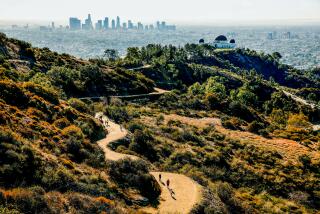Colonel Griffith J. Griffith one of L.A.’s more colorful figures
- Share via
In today’s celebrity culture, there’s no shortage of big names who ride the rollercoaster of success and shame. Just look at Charlie Sheen or Arnold Schwarzenegger.
But those outsized celebs have nothing on Colonel Griffith Jenkins Griffith, the man who bequeathed to the city what is now Griffith Park.
Griffith charmed the city of Los Angeles with his generosity, only to shock it later with an act of unhinged violence.
Although he would grant Los Angeles two more major gifts, Griffith never completely resuscitated his reputation.
Born in South Wales in 1850, Griffith immigrated to the United States as a penniless teenager. He worked as a reporter and mining advisor in San Francisco before making a fortune on his own extraction projects. In 1882, he settled in Los Angeles and purchased Rancho Los Feliz, about 4,000 acres of primarily hilly land northeast of the city.
The purchase landed Griffith among the city’s wealthy elite, and he played the part to the hilt. “He was deliberately flashy, and used to parade around with a cane and a frock coat,” said Mike Eberts, a professor at Glendale Community College and author of “Griffith Park: A Centennial History.” “Due to the poverty of his youth, he wanted to be seen as successful,” Eberts said.
Some were impressed by Griffith’s man-about-town demeanor; others were put off. One acquaintance described him as a “midget egomaniac; another as a “roly-poly pompous little fellow” who “had an exaggerated strut like a turkey gobbler,” Eberts said. And no one could ever figure out what the “Colonel” stood for, since the only military title he’d ever officially held was a “major” of rifle practice with the California National Guard.
In 1887, Griffith married Mary Agnes Christina Mesmer, the daughter of a prominent family, and further cemented his position in Los Angeles society. In December 1896, as a Christmas gift, Griffith delighted city officials by donating 3,015 acres of the ranch to the city for use as a public park. “It must be made a place of recreation and rest for the masses, a resort for the rank and file, for the plain people,” he stipulated. “I consider it my obligation to make Los Angeles a happier, cleaner and finer city. I wish to pay my debt of duty in this way to the community in which I have prospered.”
A few years later, however, Griffith’s life took a troubling turn. His drinking got out of hand. He suffered paranoid delusions and was convinced his wife and the pope were conspiring to poison him, according to Eberts. (His wife was Catholic; Griffith was Protestant.)
This dark spiral came to a terrible climax in September 1903 as Griffith and his wife were winding up a summer vacation in the presidential suite of the Arcadia Hotel in Santa Monica. Mrs. Griffith was packing a trunk when “Griffith entered the room and pulled his revolver,” the Los Angeles Times said. “He pointed it at Mrs. Griffith and said, ‘Get your prayer book and kneel down and cover your eyes. I’m going to shoot you, and going to kill you.’ ”
He aimed the gun and fired; the bullet struck Mrs. Griffith in the eye. She jumped out the window and landed on the roof below, fracturing her shoulder, but was able to crawl to safety through another window.
Griffith at first declared the shooting accidental, but the police eventually got a warrant for his arrest. He agreed to surrender, but at the last moment went bar-hopping instead. “The police sent out a deputy named Longfellow to find him,” Eberts said. “It was sort of like the O.J. Simpson chase, but real low-speed.” Longfellow tailed Griffith for about 10 miles until he finally caught up with him.
After a sensational trial in which defense attorney Earl Rogers argued that Griffith suffered from “alcoholic insanity,” Griffith was found guilty of assault with a deadly weapon. The trial took its toll on him. “It was hard to realize that the humbled, hunched-up little man with pleading eyes was the same Griffith who used to go swaggering around town,” The Times said.
Griffith was sentenced to two years at San Quentin. “Prison gave him a chance to dry out and examine his life,” Eberts said. “He left a better man.”
Disfigured and blind in one eye, Griffith’s wife divorced him.
Griffith returned to Los Angeles determined to do good and rehabilitate his reputation. He’d long desired to make science more accessible to the public, and in 1912, he offered the city $100,000 to build an observatory atop Mt. Hollywood. The city, however, was reluctant to move forward, perhaps because city leaders didn’t want it to be a monument to a disgraced man, according to Eberts.
In 1913, Griffith offered the city $50,000 to build a Greek theater, according to Eberts, but the city dragged its feet on that project as well. Ultimately Griffith set up a trust to fund his two pet projects after his death. He died in 1919; the Greek Theatre was built in 1930 and Griffith Observatory in 1935.
Today, the venues he created are vital landmarks of the city. “He was definitely a flawed man,” Eberts said. “But I can’t think of anyone who gave the city a bigger gift.”
More to Read
Sign up for Essential California
The most important California stories and recommendations in your inbox every morning.
You may occasionally receive promotional content from the Los Angeles Times.









